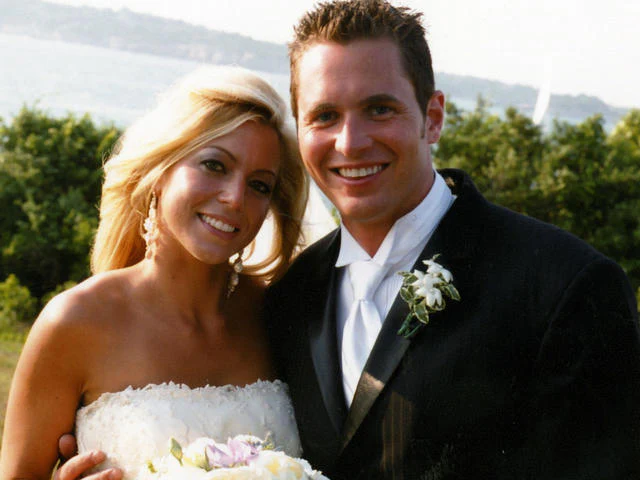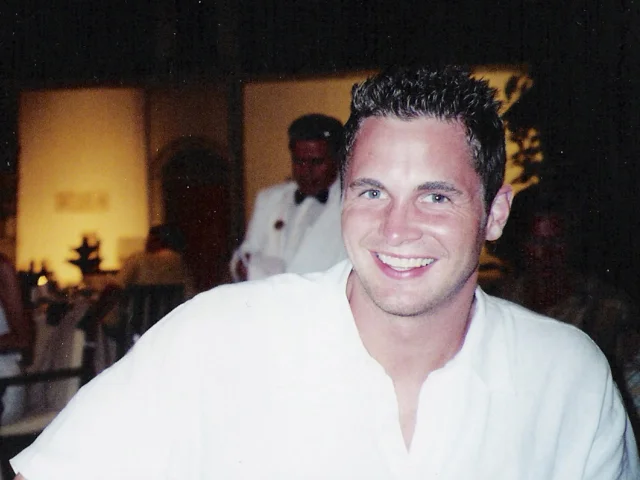In the early hours of July 5, 2005, a honeymoon cruise in the Mediterranean turned into a nightmare. George Allen Smith IV, a 26-year-old from Connecticut, vanished from Royal Caribbean’s Brilliance of the Seas. He had been married to Jennifer Hagel for just eleven days, and the couple was celebrating their new life together with a two-week voyage.
A Young Man with Big Dreams
George was born on October 3, 1978, and grew up in Connecticut. Friends and family described him as lively, funny and magnetic. His mother, Maureen Smith, called him a “fine young man” who was hardworking and “just an all-around great kid.” His father, George Smith III, remembered him as “the funniest guy” whose good looks and personality made him popular with everyone.
George wasn’t just coasting on charm. He was preparing to take over his family’s liquor store in Greenwich, Connecticut, with plans to modernize and expand it. He had both ambition and a knack for winning people over, traits his father said would help him turn the business into something bigger.
He also had a softer side. After meeting Jennifer Hagel, an aspiring schoolteacher, the two dated for three years before tying the knot. Their wedding in Newport, Rhode Island, overlooking the ocean, was described by George’s sister Bree as “a storybook wedding… absolutely beautiful.” It seemed like the perfect beginning.
The Night Everything Changed

Onboard the Brilliance of the Seas, George and Jennifer quickly settled into the social scene. They met other newlyweds, Paul and Galina Kvitnisky and spent time sightseeing and hanging out in the ship’s casino.
George enjoyed gambling, especially craps, though he wasn’t known for holding his alcohol well. “After a couple beers, you could tell,” one friend later said.
On the night of July 4, the couple joined others in the casino. George played at the craps table while Jennifer stuck to blackjack.
According to CBS News, among those around them was Josh Askin, a college student from California and a trio of Russian-American men—cousins Zachary and Greg Rozenberg, and their friend Rusty Kofman. That group would become central to the story of what happened next.
As the night wore on, the atmosphere shifted. In the ship’s disco, passengers later recalled tension between George and Jennifer.
According to an attorney representing Kofman, witnesses saw Jennifer kick George in the groin during an argument. The casino manager, Lloyd Botha, followed her out of the venue and from there the night fractured into conflicting accounts.
What is known is this: by 3:52 a.m., George was escorted back to his cabin by Askin and the Russian-American men. Jennifer wasn’t there. She was later found passed out in a hallway. But neighbors near the Smith cabin heard something disturbing.
The Sounds of a Struggle

Clete Hyman, a vacationing deputy police chief, was staying nearby. He later told investigators he heard an argument, the sound of cupboard doors slamming and then a loud thud at around 4:30 a.m. Other passengers in adjoining cabins also reported noise—banging, raised voices and then sudden silence before the final crash.
That thud is believed to be the moment George went overboard.
At sunrise, around 7:30 a.m., a 16-year-old passenger named Emilie Rausch spotted something chilling. She was taking photos near the lifeboats when she noticed a large bloodstain on the lifeboat canopy, the NBC News reports.
“I noticed there was this blood stain on it,” says Rausch. “And I didn’t think it was blood at first. I thought I was hoping maybe it was paint or maybe something else.”
Security quickly confirmed that the occupants of the Smith cabin were missing. Jennifer was eventually located, disoriented with little memory of the night. George was gone.
Inside the cabin, investigators found blood on the bedsheets—two small stains that appeared to be George’s. Some believed he had injured his wrist while fighting off someone. To his family, this wasn’t an accident. Bree Smith put it bluntly: “I think that’s outrageous. I think that’s disgusting,” when officials floated the idea of a drunken fall.
Last Men Seen with George

The spotlight quickly turned to the four men who had been with George last. Josh Askin and the Russian-American cousins denied involvement. They told Turkish police and the FBI that they had left George in his cabin and never saw him again.
But their behavior raised questions. A homemade video surfaced, showing the men laughing about George’s disappearance shortly after it happened. One voice joked about “parachute riding” off the balcony. Another flashed gang signs and said, “Told ya I was gangsta.”
When questioned later, Askin invoked his Fifth Amendment rights repeatedly. So did Zachary Rozenberg. Rusty Kofman claimed to have little memory of events. Only Greg Rozenberg gave something close to cooperation, admitting, “I hope one day that they find out the truth,” and insisting George’s death wasn’t an accident.
Their supposed alibi also fell apart. They claimed to have ordered food for a “room service party” in the early morning hours. But ship records showed no orders placed. Crew members also reported complaints about the men for sneaking liquor aboard and harassing staff.
Adding to the shadow, an 18-year-old female passenger accused the Russian-American men of sexually assaulting her during the same cruise. Police said jurisdictional limits prevented charges. The men’s lawyers claimed the encounter was consensual and even produced a videotape as proof, per The New York Times.
Jennifer Hagel’s Controversial Role
Jennifer Hagel, the bride who became a widow in less than two weeks, faced her own scrutiny. Some questioned why she had left George alone that night. Others criticized her decision to accept a $1.1 million settlement from Royal Caribbean in 2006.
She tried to defend herself publicly. Appearing on national television, she said, “Not only to lose your memory but to have nobody believe you… I don’t know what happened.” But George’s family remained skeptical of her actions. They felt the settlement silenced critical questions about the ship’s role in mishandling evidence.
From the start, the FBI treated George’s case as suspicious. Agents boarded the ship in Turkey and began gathering evidence. The case dragged on for nearly a decade. The Smith family pushed relentlessly, hiring lawyers and appearing on TV to keep the case alive.
Yet in January 2015, the FBI closed the investigation, citing insufficient evidence. The official line leaned toward the accident, per AP News. For George’s sister Bree, that was unacceptable. “How do you go through 97,000 pages of an investigation and then say it’s an accident?” she asked.
His parents vowed never to give up. “We just have to keep pushing the buttons. We won’t let it go. It’s our son,” Maureen Smith told reporters.
Strange Twists in Later Years

The story didn’t end with the case closure. In December 2019, one of the key figures—Greg Rozenberg—was shot and killed outside his home in Davie, Florida. Police opened a homicide investigation but no arrests were made.
Meanwhile, George’s case actually led to some real changes. Lawmakers used his story as an example when they worked on new rules to protect people on cruise ships, aiming to improve transparency and safety at sea. Families wanted stronger rules for reporting crimes and better investigative protocols.
Nearly twenty years later, the mystery of what happened to George Smith IV still lingers. Was he thrown overboard during a fight? Did a drunken stumble somehow explain the bloodstains and chaos inside the cabin? Or was there something darker, hidden behind the laughter of the men in that disturbing video?
For his family, the answers matter as much today as they did in 2005. They believe foul play was covered up and that someone out there still knows the truth.
Let’s dig into how major cases reshape the law.
How High-Profile Cases Influence Lawmaking
High-profile cases have a way of pulling the whole country into one big courtroom. They’re not just about one person or one crime anymore — they end up feeling like they’re about all of us.
Suddenly, families are talking about it at dinner, the news can’t stop covering it and people argue about it online. Everyone wants to know if the system is fair or broken.
And when a case gets that much attention, lawmakers can’t just ignore it. They feel pressure to step in, change old laws or make new ones to fix the problems the case exposed.
Sometimes these cases are tragedies, sometimes they’re scandals, sometimes they’re victories that change the way America sees itself. But what they almost always do is shift the law in ways that affect millions of people, long after the courtroom lights fade.
Court Precedents
Some of the most powerful changes in American law didn’t start in Congress at all. They started in a courtroom with judges making calls that echoed through history.
Take Marbury v. Madison (1803). It sounds dry but it’s basically the reason courts can throw out laws that go against the Constitution. “Judicial review,” as it’s called, gave the judiciary teeth.
From then on, Congress could write laws, sure, but if they clashed with the Constitution, the courts had the final say. That case set the boundaries lawmakers still have to respect today.
Fast-forward a century and a half to Brown v. Board of Education (1954). Imagine being a Black child told you can’t attend the same school as your white neighbors because the law says “separate but equal” is fine. The Supreme Court tore that apart, declaring segregation in schools unconstitutional.
That ruling didn’t just sit in the law books — it lit a fire under the civil rights movement and pushed lawmakers to pass real, sweeping reforms that dismantled segregation in buses, restaurants, housing and beyond.
Other rulings dug into criminal justice. Mapp v. Ohio (1961) slammed the brakes on police using illegally seized evidence in trials. That forced lawmakers to tighten rules around search and seizure, making sure citizens’ Fourth Amendment rights weren’t just theory but practice.
A few years later, Miranda v. Arizona (1966) changed how every police officer in America does their job. After that ruling, cops had to say those famous words: “You have the right to remain silent…” It wasn’t just TV drama — it became law, shaping how arrests happen nationwide.
These cases show how a single courtroom fight can snowball into nationwide reform. The decisions don’t just resolve one person’s problem. They redraw the map of American law.
Scandals and Reform
Not all changes come from constitutional battles. Sometimes it’s scandals — the kind that dominate headlines for months — that push Congress into action.
Remember Enron? In the early 2000s, this energy giant looked unstoppable. Then the truth came out: the company was cooking its books, lying to investors and leaving thousands of employees with destroyed pensions.
As journalist Bethany McLean put it, “It was the smartest guys in the room who turned out to be the biggest frauds.” Public trust in corporate America tanked. Lawmakers scrambled to rebuild it.
The result was the Sarbanes-Oxley Act of 2002. It toughened corporate accountability, tightened auditing practices and made executives personally responsible for their company’s financial honesty. Enron didn’t just ruin lives; it rewrote financial law.
Then there was the Rodney King beating in 1991. A bystander’s video showed four LAPD officers brutally attacking King after a high-speed chase. When a jury acquitted the officers, Los Angeles exploded — literally.
Riots left 63 dead and thousands injured. The footage was undeniable. “It was the first viral video of police brutality,” the Los Angeles Times later wrote. That case forced lawmakers and local governments to rethink policing.
Reforms like body cameras, civilian review boards and new training programs became part of the conversation — not just in California but nationwide.
Scandals and outrage don’t just disappear. They leave lawmakers with no choice but to respond.
Social Policy
Some of the biggest battles in American politics have started in courtrooms and then spilled into legislatures. Few cases prove this better than Roe v. Wade (1973).
For decades, women in many states faced strict, sometimes near-total bans on abortion. Roe changed that, establishing abortion as a constitutional right under the Fourteenth Amendment. It didn’t end the debate — it supercharged it.
From 1973 on, state legislatures worked nonstop to pass laws testing the limits of Roe. Some tried to protect abortion access while others tried to chip away at it. Roe became the reference point for almost every reproductive health law in the country.
Fast forward to 2022. The Supreme Court overturned Roe, handing abortion regulation back to individual states. The result was a patchwork of laws so varied it depends on your ZIP code whether you can access abortion care or not.
Within months, dozens of legislatures were rushing to either restrict or expand abortion access. One case, one ruling, decades of legislative ripple effects.
High-profile litigation doesn’t end with the judgment. It starts waves of lawmaking that crash again and again.
Media Pressure
The media is the megaphone that turns a courtroom fight into a national debate. Without it, many high-profile cases wouldn’t carry the same weight.
Take the Brock Turner sexual assault case. Turner, a Stanford student, was convicted of assaulting an unconscious woman in 2016. The judge sentenced him to just six months in county jail, sparking outrage nationwide.
The New York Times quoted the victim’s powerful courtroom statement: “You don’t know me, but you’ve been inside me.” That line traveled across every screen and newspaper in America.
The backlash was so fierce that California lawmakers passed bills tightening sentencing for sexual assault, universities also scrambled to revise policies on consent and reporting. Media turned one local trial into a national push for reform.
Or think about the Casey Anthony trial. In 2011, Anthony was acquitted of murdering her two-year-old daughter, Caylee. The verdict stunned the country. CNN, NBC and nearly every major outlet covered the case wall-to-wall.
The intense media spotlight forced lawmakers in several states to look at gaps in child protection laws. Some pushed for new requirements on reporting missing children. The debate wasn’t just about Anthony — it was about fixing the laws so that no similar case could slip through again.
The media doesn’t just report cases. It multiplies their impact, making sure lawmakers feel the heat.
Procedure and Sentencing
Sometimes the influence of a case is more technical but no less important. High-profile rulings about what evidence can be admitted, how suspects are interrogated or how sentencing is handled have forced lawmakers to act.
When courts catch stuff like cops forcing people to confess or using sketchy questioning, lawmakers usually jump in and make new rules. That’s how we ended up with things like the right to have a lawyer, clear rules about using DNA in trials and deadlines so cases don’t drag on forever.
And then there’s sentencing. If people think the punishment doesn’t match what the person did, lawmakers usually hurry to change it. High-profile cases have made penalties way tougher for crimes like child abuse, sexual assault and terrorism. Other times cases have pushed lawmakers to make sentencing more fair and make sure victims are treated better.
It demonstrates that even seemingly minor courtroom disputes can set off ripple effects, ultimately reshaping laws on a national scale.



